GABRIEL CHAILE’S SCULPTURE AT TABAKALERA
Contemplando es como fuimos cambiando (Contemplating is how we changed) is the exhibition, the first one in Spain promoted by an institution, that the CICC Tabakalera in San Sebastian is dedicating to Gabriel Chaile (San Miguel de Tucumán, Argentina, 1985), one of the most prominent names in contemporary Latin American sculpture. This proposal is intended to take an extensive look at his work, from his beginnings to his latest works produced in Lisbon, and which is recognizable by his monumental adobe, clay and metal pieces that reflect the morphology of the pre-Columbian ceramics of his native region.
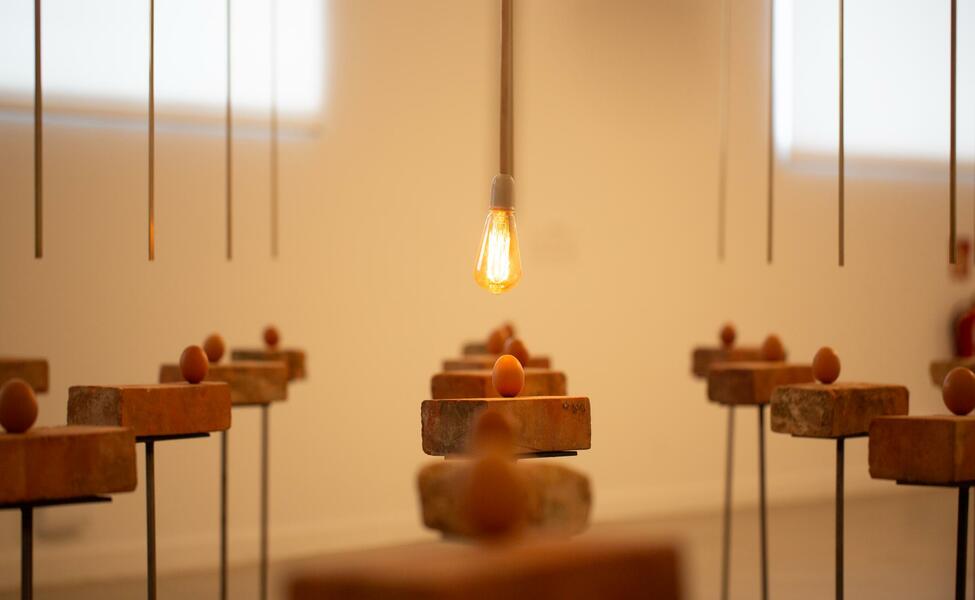
Chaile continues to investigate ancestral techniques in order to construct alternative narratives and thus enter into the options of a rereading of the relationships between past and present and the individual and the collective. Although the Argentine artist expresses himself mainly through the language of sculpture, he frequently explores the possibilities offered by drawing or installation to accurately reflect the meanings of identity, tradition and memory.
This exhibition also approaches the forms of collective work in the studio where Gabriel Chaile works in Lisbon, the place where he arrived after the pandemic, and where he shares his individual practice with the collective practice of his colleagues. In this sense, in Contemplando es como fuimos cambiando also participates Tomás Bargão, a member of the team invited by the artist and who contributes to the exhibition with a newly produced piece.
Gabriel Chaile. Contemplando es como fuimos cambiando can be seen until February 2, 2025 at CICC Tabakalera, Plaza de las Cigarreras, 1, San Sebastián (Spain).
May interest you
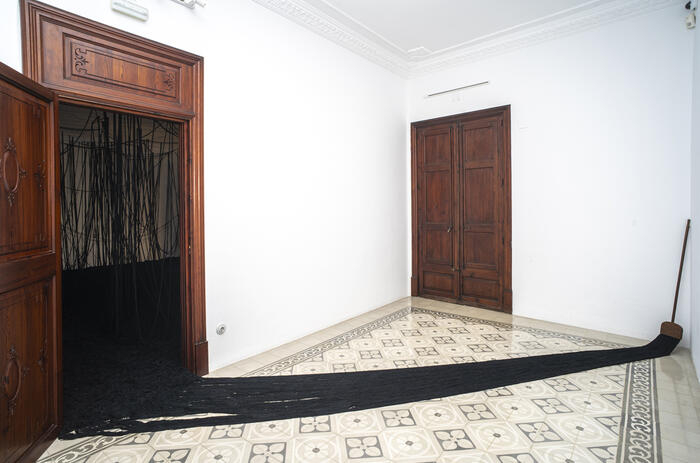
ALTTRA Foundation organizes in three spaces in Palma, on the island of Mallorca, an exhibition that addresses the theme of insularity and its role and idiosyncrasy in a globalized world through several works by Cildo Meireles (Rio de Janeiro, Brazil, 1948). The works chosen, corresponding to five different periods of the artistic production of one of the referents of Brazilian neo-conceptualism, trace a journey through some of the themes and investigations that the artist has developed throughout his life, from fortune and chance to the perception of the physically invisible but perceptible, such as sound, or the relationship between space and its use.
CILDO MEIRELES EN PALMA DE MALLORCA
ALTTRA Foundation organizes in three spaces in Palma, on the island of Mallorca, an exhibition that addresses the theme of insularity and its role and idiosyncrasy in a globalized world through several works by Cildo Meireles (Rio de Janeiro, Brazil, 1948). The works chosen, corresponding to five different periods of the artistic production of one of the referents of Brazilian neo-conceptualism, trace a journey through some of the themes and investigations that the artist has developed throughout his life, from fortune and chance to the perception of the physically invisible but perceptible, such as sound, or the relationship between space and its use.

ALTTRA Foundation organizes in three spaces in Palma, on the island of Mallorca, an exhibition that addresses the theme of insularity and its role and idiosyncrasy in a globalized world through several works by Cildo Meireles (Rio de Janeiro, Brazil, 1948). The works chosen, corresponding to five different periods of the artistic production of one of the referents of Brazilian neo-conceptualism, trace a journey through some of the themes and investigations that the artist has developed throughout his life, from fortune and chance to the perception of the physically invisible but perceptible, such as sound, or the relationship between space and its use.
CILDO MEIRELES EN PALMA DE MALLORCA
ALTTRA Foundation organizes in three spaces in Palma, on the island of Mallorca, an exhibition that addresses the theme of insularity and its role and idiosyncrasy in a globalized world through several works by Cildo Meireles (Rio de Janeiro, Brazil, 1948). The works chosen, corresponding to five different periods of the artistic production of one of the referents of Brazilian neo-conceptualism, trace a journey through some of the themes and investigations that the artist has developed throughout his life, from fortune and chance to the perception of the physically invisible but perceptible, such as sound, or the relationship between space and its use.
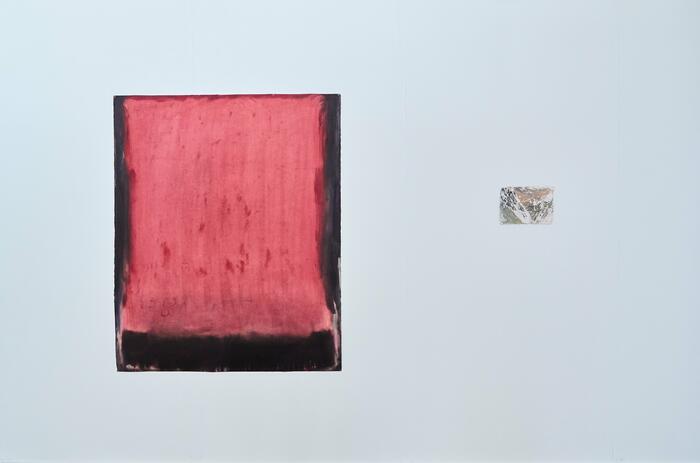
Arte al Día takes a look at the curatorial selection that highlights works by Ibero-American galleries in the NEXT, RADAR and Main sections of Pinta Miami. The curatorial team for the 2024 edition of the fair is integrated by Irene Gelfman -global curator of Pinta and co-curator of FORO and Special Project-, Giuliana Vidarte -curator of NEXT and co-curator of FORO and Special Project- and Angelica Arbelaez -curator of RADAR.
CURATORS' PICKS: THREE PROPOSALS AT PINTA MIAMI
Arte al Día takes a look at the curatorial selection that highlights works by Ibero-American galleries in the NEXT, RADAR and Main sections of Pinta Miami. The curatorial team for the 2024 edition of the fair is integrated by Irene Gelfman -global curator of Pinta and co-curator of FORO and Special Project-, Giuliana Vidarte -curator of NEXT and co-curator of FORO and Special Project- and Angelica Arbelaez -curator of RADAR.

Isabel Hurley Gallery in Malaga dedicates an exhibition as a tribute to Alberto Borea (Lima, Peru, 1971- ibidem, 2020). El negro estuvo aquí (2008-2013) goes through his last five years of production through a selection of representative works that were part of the solo shows Ruinas y ciudades, Mountains of America and Turista El Dorado, all of them exhibitions that the Peruvian made in this same gallery, in addition to the proposals made to be exhibited in Volta NY 2011 and ARCO 2013.
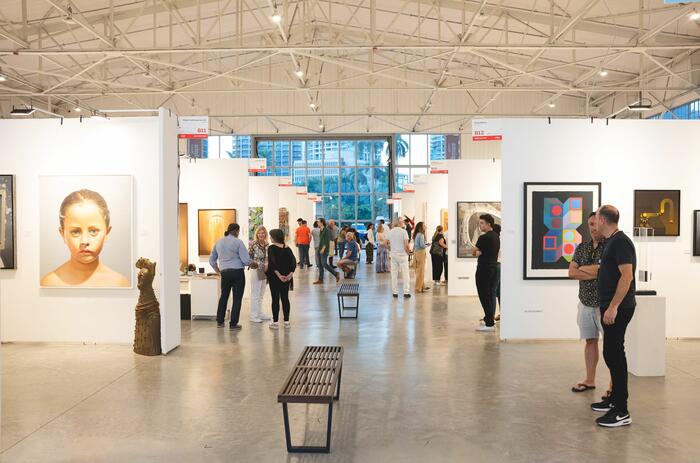
Since its foundation in 2007 in New York, Pinta has established itself as a key event in promoting Latin American, Spanish, and Portuguese art. What began as a boutique fair in the Big Apple has evolved into a global concept connecting artists, galleries, and collectors worldwide.
PINTA: A SUCCESS STORY IN LATIN AMERICAN ART
Since its foundation in 2007 in New York, Pinta has established itself as a key event in promoting Latin American, Spanish, and Portuguese art. What began as a boutique fair in the Big Apple has evolved into a global concept connecting artists, galleries, and collectors worldwide.
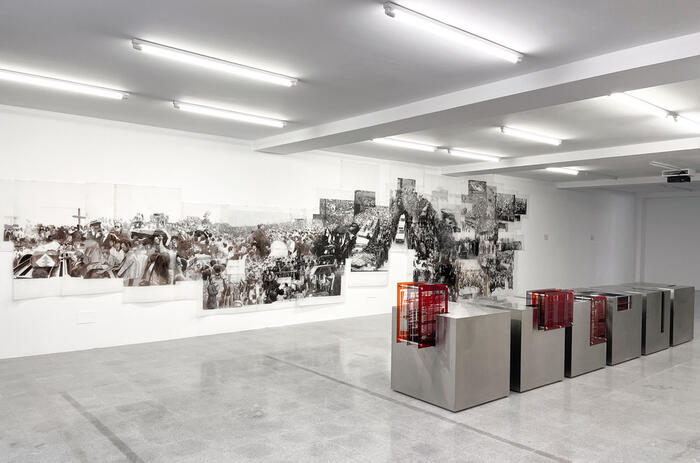
The work of Voluspa Jarpa (Rancagua, Chile, 1971) has had a very preeminent focus on the political concept surrounding archiving and its documents. Attracted to investigate more about its multiple meanings as a result of the declassification of secrets, specifically the one carried out by the Clinton administration regarding the 1973 coup d'état against Salvador Allende, the artist begins a discursive investigation on the importance of the archival support and the materiality it has as a political document, which leads her to qualify that presupposed legibility.
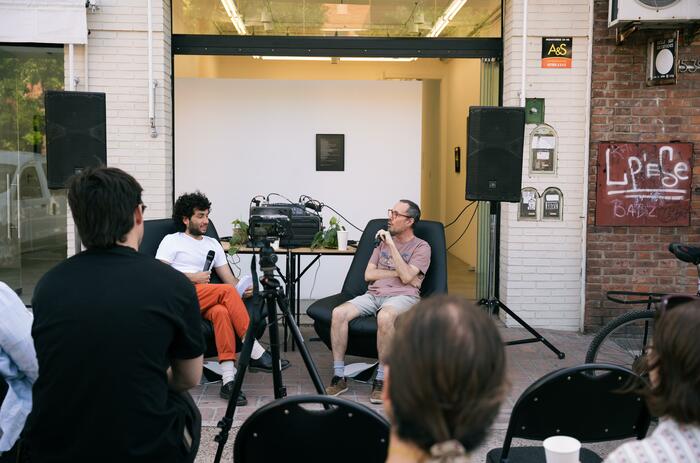
The Departamento 112 gallery -located in Martinez, province of Buenos Aires, Argentina- began by occupying an apartment, then became a garage and finally settled in a disused space that, converted into a hall, provides a view over the entire block.
DEPARTAMENTO 112: A PROPOSAL THAT REDEFINES ARGENTINA'S EMERGENT ART
The Departamento 112 gallery -located in Martinez, province of Buenos Aires, Argentina- began by occupying an apartment, then became a garage and finally settled in a disused space that, converted into a hall, provides a view over the entire block.
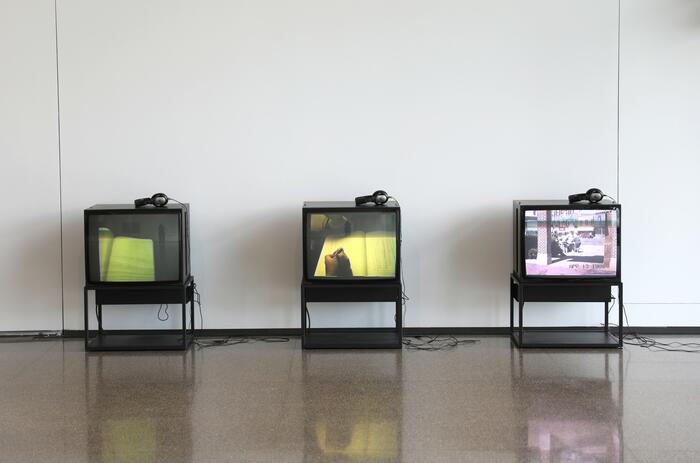
The exhibition Contar Rutinas (Counting Routines) dedicated by the Cerezales Antonino and Cinia Foundation to the work of Ana Amorim (São Paulo, Brazil, 1956) includes a selection of actions and performative works and installations that reflect the activity of the Brazilian artist from the 1980s to the present. The architecture of this exhibition is marked by the artist's daily conceptual and performative routines, reflecting their influence in the results of monumental dimensions.
ANA AMORIM'S REGISTER OF THE ROUTINE
The exhibition Contar Rutinas (Counting Routines) dedicated by the Cerezales Antonino and Cinia Foundation to the work of Ana Amorim (São Paulo, Brazil, 1956) includes a selection of actions and performative works and installations that reflect the activity of the Brazilian artist from the 1980s to the present. The architecture of this exhibition is marked by the artist's daily conceptual and performative routines, reflecting their influence in the results of monumental dimensions.
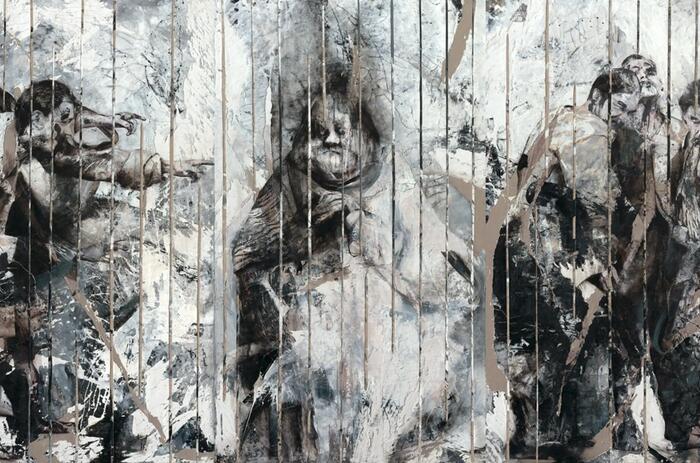
Goya's Los Disparates preceded, or marked, painting's entry into modernity. Beyond this historiographical note, the series by the Aragonese master captures with masterful imagery the vicissitudes of irony, sarcasm and the darkness of a reality that has lasted through time to the present day. The plates of his etchings become the surface that deposits this reality, and the result, once impregnated, works as a full reminder of the origin of our essence, our fears and our actions.
LITA CABELLUT IN DIALOGUE WITH GOYA
Goya's Los Disparates preceded, or marked, painting's entry into modernity. Beyond this historiographical note, the series by the Aragonese master captures with masterful imagery the vicissitudes of irony, sarcasm and the darkness of a reality that has lasted through time to the present day. The plates of his etchings become the surface that deposits this reality, and the result, once impregnated, works as a full reminder of the origin of our essence, our fears and our actions.

ALTTRA Foundation organizes in three spaces in Palma, on the island of Mallorca, an exhibition that addresses the theme of insularity and its role and idiosyncrasy in a globalized world through several works by Cildo Meireles (Rio de Janeiro, Brazil, 1948). The works chosen, corresponding to five different periods of the artistic production of one of the referents of Brazilian neo-conceptualism, trace a journey through some of the themes and investigations that the artist has developed throughout his life, from fortune and chance to the perception of the physically invisible but perceptible, such as sound, or the relationship between space and its use.
CILDO MEIRELES EN PALMA DE MALLORCA
ALTTRA Foundation organizes in three spaces in Palma, on the island of Mallorca, an exhibition that addresses the theme of insularity and its role and idiosyncrasy in a globalized world through several works by Cildo Meireles (Rio de Janeiro, Brazil, 1948). The works chosen, corresponding to five different periods of the artistic production of one of the referents of Brazilian neo-conceptualism, trace a journey through some of the themes and investigations that the artist has developed throughout his life, from fortune and chance to the perception of the physically invisible but perceptible, such as sound, or the relationship between space and its use.

Arte al Día takes a look at the curatorial selection that highlights works by Ibero-American galleries in the NEXT, RADAR and Main sections of Pinta Miami. The curatorial team for the 2024 edition of the fair is integrated by Irene Gelfman -global curator of Pinta and co-curator of FORO and Special Project-, Giuliana Vidarte -curator of NEXT and co-curator of FORO and Special Project- and Angelica Arbelaez -curator of RADAR.
CURATORS' PICKS: THREE PROPOSALS AT PINTA MIAMI
Arte al Día takes a look at the curatorial selection that highlights works by Ibero-American galleries in the NEXT, RADAR and Main sections of Pinta Miami. The curatorial team for the 2024 edition of the fair is integrated by Irene Gelfman -global curator of Pinta and co-curator of FORO and Special Project-, Giuliana Vidarte -curator of NEXT and co-curator of FORO and Special Project- and Angelica Arbelaez -curator of RADAR.

Isabel Hurley Gallery in Malaga dedicates an exhibition as a tribute to Alberto Borea (Lima, Peru, 1971- ibidem, 2020). El negro estuvo aquí (2008-2013) goes through his last five years of production through a selection of representative works that were part of the solo shows Ruinas y ciudades, Mountains of America and Turista El Dorado, all of them exhibitions that the Peruvian made in this same gallery, in addition to the proposals made to be exhibited in Volta NY 2011 and ARCO 2013.

Since its foundation in 2007 in New York, Pinta has established itself as a key event in promoting Latin American, Spanish, and Portuguese art. What began as a boutique fair in the Big Apple has evolved into a global concept connecting artists, galleries, and collectors worldwide.
PINTA: A SUCCESS STORY IN LATIN AMERICAN ART
Since its foundation in 2007 in New York, Pinta has established itself as a key event in promoting Latin American, Spanish, and Portuguese art. What began as a boutique fair in the Big Apple has evolved into a global concept connecting artists, galleries, and collectors worldwide.

The work of Voluspa Jarpa (Rancagua, Chile, 1971) has had a very preeminent focus on the political concept surrounding archiving and its documents. Attracted to investigate more about its multiple meanings as a result of the declassification of secrets, specifically the one carried out by the Clinton administration regarding the 1973 coup d'état against Salvador Allende, the artist begins a discursive investigation on the importance of the archival support and the materiality it has as a political document, which leads her to qualify that presupposed legibility.

The Departamento 112 gallery -located in Martinez, province of Buenos Aires, Argentina- began by occupying an apartment, then became a garage and finally settled in a disused space that, converted into a hall, provides a view over the entire block.
DEPARTAMENTO 112: A PROPOSAL THAT REDEFINES ARGENTINA'S EMERGENT ART
The Departamento 112 gallery -located in Martinez, province of Buenos Aires, Argentina- began by occupying an apartment, then became a garage and finally settled in a disused space that, converted into a hall, provides a view over the entire block.

The exhibition Contar Rutinas (Counting Routines) dedicated by the Cerezales Antonino and Cinia Foundation to the work of Ana Amorim (São Paulo, Brazil, 1956) includes a selection of actions and performative works and installations that reflect the activity of the Brazilian artist from the 1980s to the present. The architecture of this exhibition is marked by the artist's daily conceptual and performative routines, reflecting their influence in the results of monumental dimensions.
ANA AMORIM'S REGISTER OF THE ROUTINE
The exhibition Contar Rutinas (Counting Routines) dedicated by the Cerezales Antonino and Cinia Foundation to the work of Ana Amorim (São Paulo, Brazil, 1956) includes a selection of actions and performative works and installations that reflect the activity of the Brazilian artist from the 1980s to the present. The architecture of this exhibition is marked by the artist's daily conceptual and performative routines, reflecting their influence in the results of monumental dimensions.

Goya's Los Disparates preceded, or marked, painting's entry into modernity. Beyond this historiographical note, the series by the Aragonese master captures with masterful imagery the vicissitudes of irony, sarcasm and the darkness of a reality that has lasted through time to the present day. The plates of his etchings become the surface that deposits this reality, and the result, once impregnated, works as a full reminder of the origin of our essence, our fears and our actions.
LITA CABELLUT IN DIALOGUE WITH GOYA
Goya's Los Disparates preceded, or marked, painting's entry into modernity. Beyond this historiographical note, the series by the Aragonese master captures with masterful imagery the vicissitudes of irony, sarcasm and the darkness of a reality that has lasted through time to the present day. The plates of his etchings become the surface that deposits this reality, and the result, once impregnated, works as a full reminder of the origin of our essence, our fears and our actions.

ALTTRA Foundation organizes in three spaces in Palma, on the island of Mallorca, an exhibition that addresses the theme of insularity and its role and idiosyncrasy in a globalized world through several works by Cildo Meireles (Rio de Janeiro, Brazil, 1948). The works chosen, corresponding to five different periods of the artistic production of one of the referents of Brazilian neo-conceptualism, trace a journey through some of the themes and investigations that the artist has developed throughout his life, from fortune and chance to the perception of the physically invisible but perceptible, such as sound, or the relationship between space and its use.
CILDO MEIRELES EN PALMA DE MALLORCA
ALTTRA Foundation organizes in three spaces in Palma, on the island of Mallorca, an exhibition that addresses the theme of insularity and its role and idiosyncrasy in a globalized world through several works by Cildo Meireles (Rio de Janeiro, Brazil, 1948). The works chosen, corresponding to five different periods of the artistic production of one of the referents of Brazilian neo-conceptualism, trace a journey through some of the themes and investigations that the artist has developed throughout his life, from fortune and chance to the perception of the physically invisible but perceptible, such as sound, or the relationship between space and its use.

Arte al Día takes a look at the curatorial selection that highlights works by Ibero-American galleries in the NEXT, RADAR and Main sections of Pinta Miami. The curatorial team for the 2024 edition of the fair is integrated by Irene Gelfman -global curator of Pinta and co-curator of FORO and Special Project-, Giuliana Vidarte -curator of NEXT and co-curator of FORO and Special Project- and Angelica Arbelaez -curator of RADAR.
CURATORS' PICKS: THREE PROPOSALS AT PINTA MIAMI
Arte al Día takes a look at the curatorial selection that highlights works by Ibero-American galleries in the NEXT, RADAR and Main sections of Pinta Miami. The curatorial team for the 2024 edition of the fair is integrated by Irene Gelfman -global curator of Pinta and co-curator of FORO and Special Project-, Giuliana Vidarte -curator of NEXT and co-curator of FORO and Special Project- and Angelica Arbelaez -curator of RADAR.

Isabel Hurley Gallery in Malaga dedicates an exhibition as a tribute to Alberto Borea (Lima, Peru, 1971- ibidem, 2020). El negro estuvo aquí (2008-2013) goes through his last five years of production through a selection of representative works that were part of the solo shows Ruinas y ciudades, Mountains of America and Turista El Dorado, all of them exhibitions that the Peruvian made in this same gallery, in addition to the proposals made to be exhibited in Volta NY 2011 and ARCO 2013.

Since its foundation in 2007 in New York, Pinta has established itself as a key event in promoting Latin American, Spanish, and Portuguese art. What began as a boutique fair in the Big Apple has evolved into a global concept connecting artists, galleries, and collectors worldwide.
PINTA: A SUCCESS STORY IN LATIN AMERICAN ART
Since its foundation in 2007 in New York, Pinta has established itself as a key event in promoting Latin American, Spanish, and Portuguese art. What began as a boutique fair in the Big Apple has evolved into a global concept connecting artists, galleries, and collectors worldwide.

The work of Voluspa Jarpa (Rancagua, Chile, 1971) has had a very preeminent focus on the political concept surrounding archiving and its documents. Attracted to investigate more about its multiple meanings as a result of the declassification of secrets, specifically the one carried out by the Clinton administration regarding the 1973 coup d'état against Salvador Allende, the artist begins a discursive investigation on the importance of the archival support and the materiality it has as a political document, which leads her to qualify that presupposed legibility.

The Departamento 112 gallery -located in Martinez, province of Buenos Aires, Argentina- began by occupying an apartment, then became a garage and finally settled in a disused space that, converted into a hall, provides a view over the entire block.
DEPARTAMENTO 112: A PROPOSAL THAT REDEFINES ARGENTINA'S EMERGENT ART
The Departamento 112 gallery -located in Martinez, province of Buenos Aires, Argentina- began by occupying an apartment, then became a garage and finally settled in a disused space that, converted into a hall, provides a view over the entire block.

The exhibition Contar Rutinas (Counting Routines) dedicated by the Cerezales Antonino and Cinia Foundation to the work of Ana Amorim (São Paulo, Brazil, 1956) includes a selection of actions and performative works and installations that reflect the activity of the Brazilian artist from the 1980s to the present. The architecture of this exhibition is marked by the artist's daily conceptual and performative routines, reflecting their influence in the results of monumental dimensions.
ANA AMORIM'S REGISTER OF THE ROUTINE
The exhibition Contar Rutinas (Counting Routines) dedicated by the Cerezales Antonino and Cinia Foundation to the work of Ana Amorim (São Paulo, Brazil, 1956) includes a selection of actions and performative works and installations that reflect the activity of the Brazilian artist from the 1980s to the present. The architecture of this exhibition is marked by the artist's daily conceptual and performative routines, reflecting their influence in the results of monumental dimensions.

Goya's Los Disparates preceded, or marked, painting's entry into modernity. Beyond this historiographical note, the series by the Aragonese master captures with masterful imagery the vicissitudes of irony, sarcasm and the darkness of a reality that has lasted through time to the present day. The plates of his etchings become the surface that deposits this reality, and the result, once impregnated, works as a full reminder of the origin of our essence, our fears and our actions.
LITA CABELLUT IN DIALOGUE WITH GOYA
Goya's Los Disparates preceded, or marked, painting's entry into modernity. Beyond this historiographical note, the series by the Aragonese master captures with masterful imagery the vicissitudes of irony, sarcasm and the darkness of a reality that has lasted through time to the present day. The plates of his etchings become the surface that deposits this reality, and the result, once impregnated, works as a full reminder of the origin of our essence, our fears and our actions.

ALTTRA Foundation organizes in three spaces in Palma, on the island of Mallorca, an exhibition that addresses the theme of insularity and its role and idiosyncrasy in a globalized world through several works by Cildo Meireles (Rio de Janeiro, Brazil, 1948). The works chosen, corresponding to five different periods of the artistic production of one of the referents of Brazilian neo-conceptualism, trace a journey through some of the themes and investigations that the artist has developed throughout his life, from fortune and chance to the perception of the physically invisible but perceptible, such as sound, or the relationship between space and its use.
CILDO MEIRELES EN PALMA DE MALLORCA
ALTTRA Foundation organizes in three spaces in Palma, on the island of Mallorca, an exhibition that addresses the theme of insularity and its role and idiosyncrasy in a globalized world through several works by Cildo Meireles (Rio de Janeiro, Brazil, 1948). The works chosen, corresponding to five different periods of the artistic production of one of the referents of Brazilian neo-conceptualism, trace a journey through some of the themes and investigations that the artist has developed throughout his life, from fortune and chance to the perception of the physically invisible but perceptible, such as sound, or the relationship between space and its use.

Arte al Día takes a look at the curatorial selection that highlights works by Ibero-American galleries in the NEXT, RADAR and Main sections of Pinta Miami. The curatorial team for the 2024 edition of the fair is integrated by Irene Gelfman -global curator of Pinta and co-curator of FORO and Special Project-, Giuliana Vidarte -curator of NEXT and co-curator of FORO and Special Project- and Angelica Arbelaez -curator of RADAR.
CURATORS' PICKS: THREE PROPOSALS AT PINTA MIAMI
Arte al Día takes a look at the curatorial selection that highlights works by Ibero-American galleries in the NEXT, RADAR and Main sections of Pinta Miami. The curatorial team for the 2024 edition of the fair is integrated by Irene Gelfman -global curator of Pinta and co-curator of FORO and Special Project-, Giuliana Vidarte -curator of NEXT and co-curator of FORO and Special Project- and Angelica Arbelaez -curator of RADAR.

Isabel Hurley Gallery in Malaga dedicates an exhibition as a tribute to Alberto Borea (Lima, Peru, 1971- ibidem, 2020). El negro estuvo aquí (2008-2013) goes through his last five years of production through a selection of representative works that were part of the solo shows Ruinas y ciudades, Mountains of America and Turista El Dorado, all of them exhibitions that the Peruvian made in this same gallery, in addition to the proposals made to be exhibited in Volta NY 2011 and ARCO 2013.

Since its foundation in 2007 in New York, Pinta has established itself as a key event in promoting Latin American, Spanish, and Portuguese art. What began as a boutique fair in the Big Apple has evolved into a global concept connecting artists, galleries, and collectors worldwide.
PINTA: A SUCCESS STORY IN LATIN AMERICAN ART
Since its foundation in 2007 in New York, Pinta has established itself as a key event in promoting Latin American, Spanish, and Portuguese art. What began as a boutique fair in the Big Apple has evolved into a global concept connecting artists, galleries, and collectors worldwide.

The work of Voluspa Jarpa (Rancagua, Chile, 1971) has had a very preeminent focus on the political concept surrounding archiving and its documents. Attracted to investigate more about its multiple meanings as a result of the declassification of secrets, specifically the one carried out by the Clinton administration regarding the 1973 coup d'état against Salvador Allende, the artist begins a discursive investigation on the importance of the archival support and the materiality it has as a political document, which leads her to qualify that presupposed legibility.

The Departamento 112 gallery -located in Martinez, province of Buenos Aires, Argentina- began by occupying an apartment, then became a garage and finally settled in a disused space that, converted into a hall, provides a view over the entire block.
DEPARTAMENTO 112: A PROPOSAL THAT REDEFINES ARGENTINA'S EMERGENT ART
The Departamento 112 gallery -located in Martinez, province of Buenos Aires, Argentina- began by occupying an apartment, then became a garage and finally settled in a disused space that, converted into a hall, provides a view over the entire block.

The exhibition Contar Rutinas (Counting Routines) dedicated by the Cerezales Antonino and Cinia Foundation to the work of Ana Amorim (São Paulo, Brazil, 1956) includes a selection of actions and performative works and installations that reflect the activity of the Brazilian artist from the 1980s to the present. The architecture of this exhibition is marked by the artist's daily conceptual and performative routines, reflecting their influence in the results of monumental dimensions.
ANA AMORIM'S REGISTER OF THE ROUTINE
The exhibition Contar Rutinas (Counting Routines) dedicated by the Cerezales Antonino and Cinia Foundation to the work of Ana Amorim (São Paulo, Brazil, 1956) includes a selection of actions and performative works and installations that reflect the activity of the Brazilian artist from the 1980s to the present. The architecture of this exhibition is marked by the artist's daily conceptual and performative routines, reflecting their influence in the results of monumental dimensions.

Goya's Los Disparates preceded, or marked, painting's entry into modernity. Beyond this historiographical note, the series by the Aragonese master captures with masterful imagery the vicissitudes of irony, sarcasm and the darkness of a reality that has lasted through time to the present day. The plates of his etchings become the surface that deposits this reality, and the result, once impregnated, works as a full reminder of the origin of our essence, our fears and our actions.
LITA CABELLUT IN DIALOGUE WITH GOYA
Goya's Los Disparates preceded, or marked, painting's entry into modernity. Beyond this historiographical note, the series by the Aragonese master captures with masterful imagery the vicissitudes of irony, sarcasm and the darkness of a reality that has lasted through time to the present day. The plates of his etchings become the surface that deposits this reality, and the result, once impregnated, works as a full reminder of the origin of our essence, our fears and our actions.

ALTTRA Foundation organizes in three spaces in Palma, on the island of Mallorca, an exhibition that addresses the theme of insularity and its role and idiosyncrasy in a globalized world through several works by Cildo Meireles (Rio de Janeiro, Brazil, 1948). The works chosen, corresponding to five different periods of the artistic production of one of the referents of Brazilian neo-conceptualism, trace a journey through some of the themes and investigations that the artist has developed throughout his life, from fortune and chance to the perception of the physically invisible but perceptible, such as sound, or the relationship between space and its use.
CILDO MEIRELES EN PALMA DE MALLORCA
ALTTRA Foundation organizes in three spaces in Palma, on the island of Mallorca, an exhibition that addresses the theme of insularity and its role and idiosyncrasy in a globalized world through several works by Cildo Meireles (Rio de Janeiro, Brazil, 1948). The works chosen, corresponding to five different periods of the artistic production of one of the referents of Brazilian neo-conceptualism, trace a journey through some of the themes and investigations that the artist has developed throughout his life, from fortune and chance to the perception of the physically invisible but perceptible, such as sound, or the relationship between space and its use.

Arte al Día takes a look at the curatorial selection that highlights works by Ibero-American galleries in the NEXT, RADAR and Main sections of Pinta Miami. The curatorial team for the 2024 edition of the fair is integrated by Irene Gelfman -global curator of Pinta and co-curator of FORO and Special Project-, Giuliana Vidarte -curator of NEXT and co-curator of FORO and Special Project- and Angelica Arbelaez -curator of RADAR.
CURATORS' PICKS: THREE PROPOSALS AT PINTA MIAMI
Arte al Día takes a look at the curatorial selection that highlights works by Ibero-American galleries in the NEXT, RADAR and Main sections of Pinta Miami. The curatorial team for the 2024 edition of the fair is integrated by Irene Gelfman -global curator of Pinta and co-curator of FORO and Special Project-, Giuliana Vidarte -curator of NEXT and co-curator of FORO and Special Project- and Angelica Arbelaez -curator of RADAR.

Isabel Hurley Gallery in Malaga dedicates an exhibition as a tribute to Alberto Borea (Lima, Peru, 1971- ibidem, 2020). El negro estuvo aquí (2008-2013) goes through his last five years of production through a selection of representative works that were part of the solo shows Ruinas y ciudades, Mountains of America and Turista El Dorado, all of them exhibitions that the Peruvian made in this same gallery, in addition to the proposals made to be exhibited in Volta NY 2011 and ARCO 2013.

Since its foundation in 2007 in New York, Pinta has established itself as a key event in promoting Latin American, Spanish, and Portuguese art. What began as a boutique fair in the Big Apple has evolved into a global concept connecting artists, galleries, and collectors worldwide.
PINTA: A SUCCESS STORY IN LATIN AMERICAN ART
Since its foundation in 2007 in New York, Pinta has established itself as a key event in promoting Latin American, Spanish, and Portuguese art. What began as a boutique fair in the Big Apple has evolved into a global concept connecting artists, galleries, and collectors worldwide.

The work of Voluspa Jarpa (Rancagua, Chile, 1971) has had a very preeminent focus on the political concept surrounding archiving and its documents. Attracted to investigate more about its multiple meanings as a result of the declassification of secrets, specifically the one carried out by the Clinton administration regarding the 1973 coup d'état against Salvador Allende, the artist begins a discursive investigation on the importance of the archival support and the materiality it has as a political document, which leads her to qualify that presupposed legibility.

The Departamento 112 gallery -located in Martinez, province of Buenos Aires, Argentina- began by occupying an apartment, then became a garage and finally settled in a disused space that, converted into a hall, provides a view over the entire block.
DEPARTAMENTO 112: A PROPOSAL THAT REDEFINES ARGENTINA'S EMERGENT ART
The Departamento 112 gallery -located in Martinez, province of Buenos Aires, Argentina- began by occupying an apartment, then became a garage and finally settled in a disused space that, converted into a hall, provides a view over the entire block.

The exhibition Contar Rutinas (Counting Routines) dedicated by the Cerezales Antonino and Cinia Foundation to the work of Ana Amorim (São Paulo, Brazil, 1956) includes a selection of actions and performative works and installations that reflect the activity of the Brazilian artist from the 1980s to the present. The architecture of this exhibition is marked by the artist's daily conceptual and performative routines, reflecting their influence in the results of monumental dimensions.
ANA AMORIM'S REGISTER OF THE ROUTINE
The exhibition Contar Rutinas (Counting Routines) dedicated by the Cerezales Antonino and Cinia Foundation to the work of Ana Amorim (São Paulo, Brazil, 1956) includes a selection of actions and performative works and installations that reflect the activity of the Brazilian artist from the 1980s to the present. The architecture of this exhibition is marked by the artist's daily conceptual and performative routines, reflecting their influence in the results of monumental dimensions.

Goya's Los Disparates preceded, or marked, painting's entry into modernity. Beyond this historiographical note, the series by the Aragonese master captures with masterful imagery the vicissitudes of irony, sarcasm and the darkness of a reality that has lasted through time to the present day. The plates of his etchings become the surface that deposits this reality, and the result, once impregnated, works as a full reminder of the origin of our essence, our fears and our actions.
LITA CABELLUT IN DIALOGUE WITH GOYA
Goya's Los Disparates preceded, or marked, painting's entry into modernity. Beyond this historiographical note, the series by the Aragonese master captures with masterful imagery the vicissitudes of irony, sarcasm and the darkness of a reality that has lasted through time to the present day. The plates of his etchings become the surface that deposits this reality, and the result, once impregnated, works as a full reminder of the origin of our essence, our fears and our actions.




